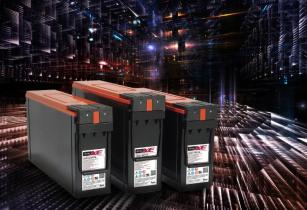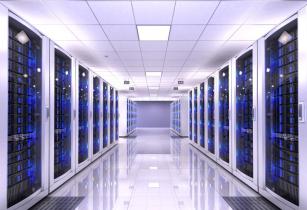Data centre operators naturally want the best class of available technology, including related batteries, for their UPS systems
Absolute reliability should be combined with energy efficiency, long operating life and attractive total cost of ownership.
Currently, the two mainstream UPS battery technologies are lead-acid and lithium-ion (Li-ion). Each has variants; Thin Plate Pure Lead (TPPL) technology, for example, is an advanced, high-performance lead-acid technology available from EnerSys?.
This article introduces the strengths and challenges of each of these technologies to potential users. Consultation with a major manufacturer such as EnerSys? is then recommended, as they can advise on the optimum balance of performance and economy for a particular application.
#1 Safe and reliable technology
TRME: Given the criticality of the applications they protect, how well proven are these most common and widely used lead-acid and Li-ion battery technologies, in terms of safety and reliability?
EnerSys: Lead-acid, as a long-established energy storage technology, is well proven in data centre applications. Many lead-acid technologies are available, and performance is well-understood to aid battery technology selection.
Li-ion batteries with a built-in, associated Battery Management System (BMS) can be considered as a safe technology, used in everyday life for numerous applications. Around two billion cells are produced annually, predominantly for consumer applications. Li-ion also offers a clean-air working environment plus good hot and cold temperature performance.
There is limited Li-ion performance data available for data centre. Li-ion requires a BMS as a redundant safety design to prevent deep discharge or overcharging. Precautions, including cell selection and overall battery design, are essential for a safe Li-ion battery solution. However, the BMS itself introduces increased complexity to the total system design, with more components.
#2 Capital costs
TRME: Is capital cost still a factor in deciding between Li-ion and lead-acid?
EnerSys: Despite historical cost reductions, Li-ion pricing remains a barrier for many users. Price depends on many factors including supplier, quality, purchase volumes and the exact chemistry used.
The type of Lithium chemistry also impacts cost. For example, Nickel-Manganese-Cobalt (NMC) is a newer technology and the preferred option for the automotive industry. This is influencing research to improve performance and reduce costs. Lithium-Iron-Phosphate (LFP) is an older technology with lower specific density and cyclic performance.
#3 Fast charge acceptance
TRME: Does Li-ion technology offer a significant fast charging advantage?
EnerSys: Li-ion does have high charge acceptance and fast charge capability, but this can also be associated with the need for a larger, and more expensive, charger.
Meanwhile, advanced TPPL battery technology reduces data centre vulnerability to multiple mains blackouts, through very short recharge times and time to repeat duty. For example, with 0.4C10 A charging current using fast charge methodology, TPPL can be fully recharged, following a one-minute discharge to 1.6 Vpc, in 2? hours, and ready to repeat duty in 22 minutes.
#4 Maintenance requirements
TRME: How can we compare Li-ion and lead-acid battery maintenance requirements?
EnerSys: Li-ion maintenance requirements are virtually zero due to built-in self-diagnostics that warn of most problems. However, Valve Regulated Lead-Acid (VRLA) batteries are also low maintenance, with no water topping-up required. Battery Monitoring Systems can be used with lead acid battery technology to provide information on operation and assist maintenance.
TPPL is a high quality, proven battery technology that can provide long service life and low downtime within data centres.
#5 Service life
TRME: How do Li-ion and lead-acid battery technologies compare on service life?
EnerSys: In UPS applications, calendar life becomes the governing factor as the batteries are mostly operated in stand-by mode with low cyclic duty. Service life depends on the lithium chemistry and technology used, together with the battery?s quality at both cell and system level.
Typically, Li-ion cells are claimed to have a have a 15 to 20-year design life at 25?C.
Alternatively, batteries with TPPL technology are currently available that can achieve a 12+ years design life, with eight to 10 years in service demonstrated. This compares well with the standard Absorbent Glass Mat (AGM) benchmark of five - six years? service life in UPS applications.
 #6 Size and weight
#6 Size and weight
TRME: Does Li-ion offer size and weight reduction compared with lead-acid?
EnerSys: Yes, by around 50 ? 70 per cent. However, Li-ion?s reduced weight is not important in data centres. Its reduced footprint and floorspace can be advantageous though, especially in colocation facilities. It may also become more important as data processing demand continues to rise sharply.
Alternatively, TPPL battery technology is available as a high energy density solution designed by EnerSys?, which offers advantages over standard lead-acid batteries.
#7 Transportation restrictions
TRME: Do the lead-acid and Li-ion battery technologies carry transportation considerations?
EnerSys: VRLA batteries, including TPPL, are classified as non-spillable and approved as non-hazardous cargo for ground, sea and air transportation. Li-ion, however, is subject to heavier legislative shipping restrictions, Class UN3480. Batteries must be shipped in a partial state of charge (PSoC) and comply with regulations for packing and can only be transported in volume on dedicated cargo airlines.
#8 Battery recycling
TRME: What are the recycling possibilities for lead-acid and Li-ion technologies?
EnerSys: Although Li-ion is 100 per cent recyclable in terms of components and materials used, recycling or disposal can be costly for end-users. Accordingly, Lithium-Iron-Phosphate (LFP) recycling is currently not commercially viable. Nickel-Manganese-Cobalt (NMC) batteries, however, have more intrinsic recycle value as they contain both nickel and cobalt.
Lead-acid batteries contain lead and other metals, acids, and plastics. On aggregate these are about 95 per cent recyclable, and therefore these battery types have inherent end-of-life value.
#9 Changing from lead-acid to Li-ion
TRME: How easy is it to reconfigure a UPS to use Li-ion instead of lead-acid batteries?
EnerSys: While both lead-acid and Li-ion batteries typically use constant voltage chargers, their charging characteristics are different. Lead-acid batteries operate on float ? the usual practice in a data centre. Li-ion types, however, are not maintained and charged at full state charge. Lead-acid and Li-ion batteries also exhibit differences in charging voltages.
Accordingly, changing from lead-acid to Li-ion would incur a change in charging architecture, and associated costs.
By contrast, upgrading from standard VRLA batteries to TPPL types will yield significantly improved performance without need to invest in new charging equipment.
#10 Summing up
TRME: Can we summarise the comparative positions of lead-acid and Li-ion technologies?
EnerSys: Li-ion is of increasing interest to data centre operators, and can be an optimum solution in applications demanding very high power density and long life ? yet its high capital cost remains a barrier. Nevertheless, the TCO analysis could change as autonomy demands change and manufacturing costs decrease.
As a well-proven technology, lead-acid will remain popular in UPS installations. Additionally, users looking to employ Li-ion technology can discuss TPPL alternatives with EnerSys?. These include the DataSafe? HX+ and DataSafe? XE battery ranges from EnerSys?. In addition, the PowerSafe SBS? EON Technology? battery range is suitable where cyclic duty is required, such as for grid support and peak shaving applications.
To learn more about UPS batteries for data centre environments, please visit: https://enersysdatacentres.com/






